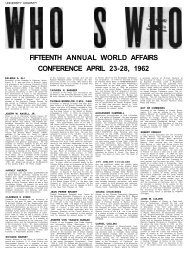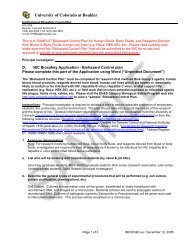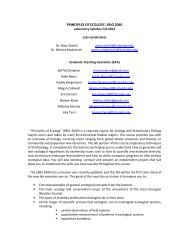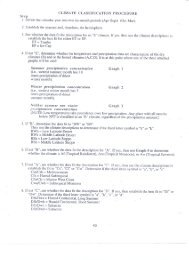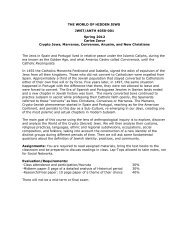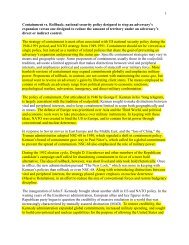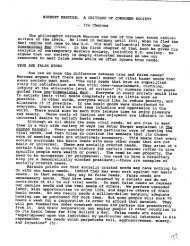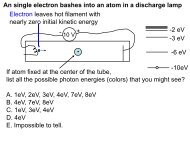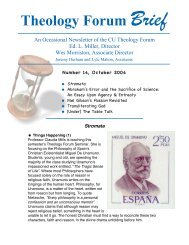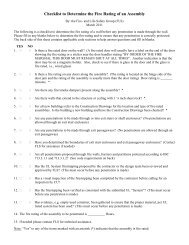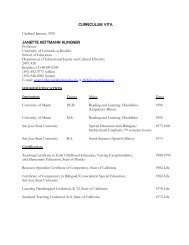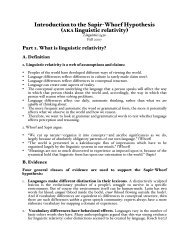Homework #4
Homework #4
Homework #4
You also want an ePaper? Increase the reach of your titles
YUMPU automatically turns print PDFs into web optimized ePapers that Google loves.
HW <strong>#4</strong>, Physics 3320, Fall 2013 Due Wednesday, Sept. 25 (start of class) <br />
1.) We have an infinitely tall solenoid (radius R, n coils per unit length)<br />
Wrapped around it is a single loop of wire (radius r, centered at the left<br />
edge of the solenoid, as shown)<br />
a) Find the mutual inductance M between the loop and the solenoid.<br />
r<br />
b) Suppose now that the loop is doubled, so (with the same radius r) it<br />
wraps around the solenoid twice. Again, find the mutual inductance M.<br />
- If the solenoid was not infinite, would the mutual inductance between the solenoid and the single<br />
loop get larger or smaller? Briefly (qualitatively only) why?<br />
c) Find the self-‐inductance per unit length of the infinite solenoid, all by itself. Explicitly check that<br />
the units of your answer work out correctly.<br />
____________________________________________________________________<br />
2.) Consider a toroidal coil of N turns of wire and square cross-‐section, with height h, inner <br />
radius a, and outer radius (a + h), as shown. The wire carries a current I. <br />
(a) Compute B, everywhere inside the torus. (Outside the torus, B=0. Why?) <br />
(b) Derive an expression for the self-inductance<br />
of the torus. <br />
-‐ If a is very large, show that this answer (re-expressed<br />
as inductance per unit length, of <br />
course) is consistent (when compared <br />
appropriately) with 1c above. (Why should it?) <br />
(c) You work at the company that <br />
manufactures these toroidal inductors. The dimensions a and h are fixed by the customer's <br />
specifications, and the mass of the copper wire you can use is fixed by your budget. Your boss <br />
wants to know if changing the diameter of the wire used will increase the ratio of inductance-to-‐resistance<br />
of the torus (L/R). Since the volume of the wire is fixed (!!), you can go with more <br />
turns of thinner wire, or fewer turns of thicker wire. (More turns means higher inductance, but <br />
thinner wire means higher resistance.) <br />
Does decreasing the diameter of the wire result in larger L/R, smaller L/R, or no change? <br />
(Assume that, whatever wire thickness you choose, thickness
4.) Consider a circuit with a capacitor and an inductor only.<br />
Suppose this LC circuit starts at time t=0 with charge Q0 on the<br />
capacitor and zero initial current.<br />
a) Write down the differential equation for charge on the capacitor as a<br />
function of time and solve for Q(t).<br />
- Find the voltage across the capacitor, the voltage across the inductor,<br />
the energy stored in the capacitor, and the energy stored in the inductor as functions of time.<br />
b) Describe in words the energy flow in the circuit.<br />
Show that the total electromagnetic energy in the circuit is conserved.<br />
c) Describe an analogous mechanical system (i.e. one that obeys the same differential equation) and<br />
provide “translations” between all important variables<br />
________________________________________________________________________<br />
This last question is subtle! But, it pulls together a lot of ideas about EMF and circuits.<br />
5.) Consider the electrical circuit shown. There is an infinitely long solenoid (shaded, shown end-on<br />
in the figure). The current around that solenoid circulates CW and increasing with time, producing a<br />
flux (into the page) that is linear in time: Φ(t)=αt.<br />
Surrounding that solenoid are some ideal wires and two<br />
resistors, as shown, with ideal voltmeters (that means they<br />
have very high internal resistance, and thus negligible<br />
current flows through them) connected as shown. (The<br />
probes of voltmeter V 1 are directly across resistor R 1 , and<br />
those of V 2 are across R 2 .)<br />
a) What do the two voltmeters read? (Including signs)<br />
How can it be that the two readings are different? (Look carefully - shouldn't points a and b have a<br />
unique voltage drop between them? If not... why not?)<br />
b) Now consider two of those circuits connected as shown in the figure below. <br />
The solenoids are identical, both with the same cross sectional area (= 0.2 m 2 ), and the <br />
magnitude of the magnetic field inside both is equal and increasing at a constant rate (= 1 T/s). <br />
(However, note the direction of the current is opposite in the two solenoids, so the B-‐fields are <br />
in fact increasing in opposite directions.) <br />
The resistors have the values shown. <br />
-‐ Determine the current passing through each resistor. (Magnitude and direction) <br />
!
Extra Credit: <br />
In class, we saw a demonstration of a “jumping ring”, where we applied AC voltage (and thus <br />
AC current) to a solenoid, and a ring of copper wrapped around the solenoid was launched into <br />
the air. Griffiths also talks about this demo (example 7.6, see his figure!) The explanation that I <br />
gave in class went something like this: “The changing flux caused by the alternating current in <br />
the solenoid induces a current in the copper ring. The current in the ring causes a magnetic <br />
field which opposes the field from the solenoid, so the ring is forced away from the solenoid.” <br />
Now I’m changing my story. I claim that during some parts of the cycle, the induced current in the<br />
ring causes a magnetic field in the same direction as the field from the solenoid, thus pulling the<br />
ring back on to the solenoid!<br />
(a) Show that in the simplest approximation, the time-averaged force on the ring is zero!<br />
(b) Show that if there is a small phase lag in the response of the ring (due to, say, the self-inductance<br />
of the ring), so that its response is slightly time delayed with respect to the ideal case, then the time<br />
average force will be nonzero, directed away from the solenoid.<br />
Hint: Note that we are not asking you to compute the numerical force on the ring. That would be a<br />
significantly harder problem (you would need more information.) We are only asking for the sign of<br />
the answer. Think about the force between two nearby current loops – parallel currents attract,<br />
opposites repel, with a force proportional to current.



